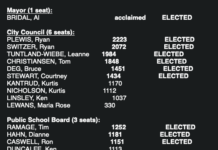The Chinook School Division will continue to proceed with staff reductions after the April 10 provincial budget did not address funding shortfalls which have occurred in Chinook over the past few budgets.
The provincial government announced a 1.6 per cent increase in funding province wide for PreK-12 education in their 2018-2019 budget. The budgeted amount included a promised restoration of $30 million in educational funding, but that total falls short of the $54 million cut as part of austerity measures in the 2017-2018 budget.
For the Chinook School Division, the impact of this year’s budget is approximately $275,000 less than the previous year, and the $75.2 million in grant funding does not address the $6.5 million budget reduction Chinook experienced at the start of the 2017-2018 school year.
Earlier, in response to budgetary constraints, the division announced they are embarking on a two year board approved strategy to reducing the teaching staff in Chinook. The amended staffing formula that has been approved increases the optimal class size in every classroom.
“The schools will be given a staffing allocation based on their enrolments. And they will need to manage that. They will need to find a way to address the staff and cover off all the programs. Will it result in larger class sizes? Probably. Could it result in split classes in more places than had been before? Likely. But that is just what we have to do in order to be able to live within our means,” Chinook’s Chief Financial Officer Rod Quintin explained a day after learning about the budget funding total coming to the Southwest.
“Probably the biggest factor is that the province as a whole is growing, but we aren’t. So the resources are following the students. And those students happen to be growing, in terms of numbers, in and around Saskatoon and Regina,” he said.
Chinook is operating with a mandate to balance their budget by 2019-2020, a plan that has already been approved by ministry officials.
“We’re still looking at a need to address our operational deficit. We have been doing some projections, and been working with the board around how we start to address that,” he said. “I think its been fairly widely stated that we need to probably look at our staffing formula and try and achieve some staff reductions, hopefully through attrition.”
“This (budget) has done really nothing to offset that need,” he noted of the funding from the provincial government which is causing them to project a budget shortfall of $2 million to $2.5 million in their upcoming annual budgets. “We need to find that over the next two years in order to get back to a balanced budget.”
He said the division is hoping to achieve their staff reductions though attrition, but they could utilize redundancy to reach their reduction targets. However, there is a two year implementation of this strategy.
“We’re going to do the best we can this year, and then try and complete that goal next year.”
In previous budgets Chinook had benefited from dispersion funding in recognition of having to operate schools and deliver education across a large geographic area.
“The emphasis on those two categories – the fixed costs related to us having a lot of schools and a lot of distance – changed last year when the funding was re-developed a little bit. So there was less emphasis on those fixed costs – more emphasis on the what I would call the variable costs which are the students – and that is the new regime that we have to live within.”
“We’re at a place now that we need to be able to manage whatever that brings to us.”
“We’re fairly confident we can manage it. It doesn’t mean that it’s going to be completely painless. There is going to be some issues that we have, tough decisions that have to made in order to get to that place that we need to be. But at the end of it all, we need to be in a place of having a balanced budget. That is the law. So we really don’t have any choice. It’s just we do have a little bit of flexibility about when we are able to get there.”






